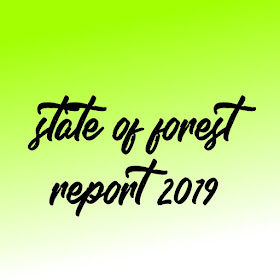STATE OF FOREST REPORT 2019
The report is published by the Forest Survey of India (FSI) which has been mandated to assess the forest and tree resources of the country including wall-to-wall forest cover mapping in a biennial cycle. Starting 1987, 16 assessments have been completed so far. ISFR 2019 is the 16th report in the series.
SALIENT FEATURES
• India is among the few countries in the world where forest c over is consistently increasing.
• Total forest and tree cover of the country is 80.73 million hectare which is 24.56 percent of the geographical area.
ο Total forest cover – 21.67%
ο Tree cover – 2.89%
• As compared to 2017, there is an increase of 5188 sq km in t he total forest and total tree cover (forest cover – 3976 sq k m; tree cover – 1,212 sq km).
• Forest cover in the hill districts is 40.3%.
• Total forest cover in the tribal districts is 37.54%.
• Forest cover within the reserved forest are has shown a slight decrease of 330 sq km (0.05%).
• Highest range increase in forest cover has been observed i n open forest followed by very dense forest and moderately dense forest.
• Top three states showing increase in forest cover are Karnataka (1,025 sq. km) followed by Andhra Pradesh (990 sq km) and Kerala (823 sq km), Jammu and Kashmir and Himachal Pradesh.
• Total Forest cover in the North Eastern Region is 65.05% of its geographical area. Current assessment shows a decrease of forest cover to the extent 0.45% in the region.
Except Assam and Tripura, all the States in the region show d ecrease in forest cover.
• Soil Organic Carbon represents the largest pool for carbon stock in forests – 56% to the total forest carbon stock of t he country
Area-wise Madhya Pradesh has the largest forest cover i n the country followed by Arunachal Pradesh, C hhattisgarh, Odisha and Maharashtra.
• In terms of forest cover as percentage of total
geographical area, the top five States are Mizoram
(85.41%), Arunachal Pradesh (79.63%), Meghalaya
(76.33%), Manipur (75.46%) and Nagaland (75.31%).
• Mangrove cover has been separately reported in the ISFR 2019
ο Total mangrove cover in the country is 4,975 sq km.
ο An increase of 54 sq Km in mangrove cover has been observed as compared to the previous assessment of
2017.
ο Top three states showing mangrove cover increase are Gujarat (37 sq km) followed by Maharashtra (16 sq km) and Odisha (8 sq km).
• The extent of bamboo bearing area of the country has been estimated 16.00 million hectare – an increase of 0.32 million hectare.
• Under the current assessment the total carbon stock in country’s forest is estimated 7,124.6 million tonnes and there an increase of 42.6 million tonnes in the carbon stock of country as compared to the last assessment of 2017.
• FSI has carried out an exercise at the national level to identify wetlands of more than 1 ha within RFA.
ο There are 62,466 wetlands covering 3.8% of the area
within the RFA/GW of the country.
ο Total number of wetlands located within reserved forest area is 8.13%.
ο Amongst the States, Gujarat has largest area of
wetlands within reserved forest area followed by West
Bengal.
• The report included a chapter on forest and people which collects information on the dependence of the people living in close proximity to forests for their day to day needs for forest produce such as Fuelwood, Fodder, Small timber and bamboo.
Follow click here




